Supermarine Spitfire Mk.IXc
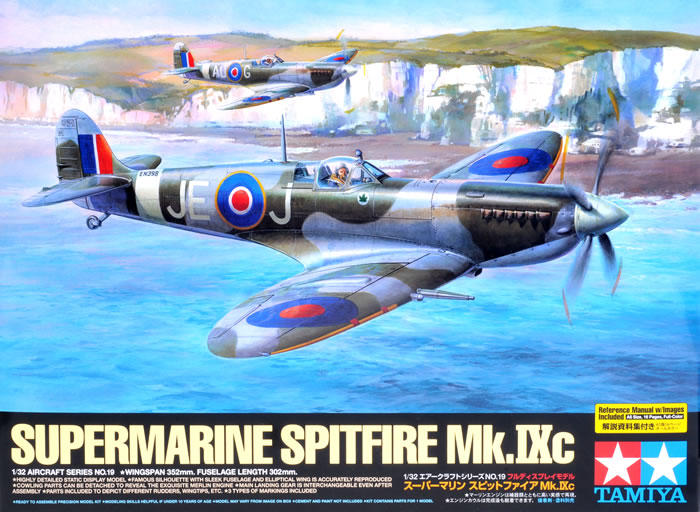
Tamiya, 1/32 scale
S
u m m a r y |
| Catalogue Number and Description: |
Tamiya Kit Number 60319 - Supermarine Spitfire Mk.IXc |
| Scale: |
1/32 |
| Contents and Media: |
360 parts in grey plastic; 17 parts in clear; two nickel-plated photo-etched frets; six parts in flexible black vinyl; eight steel pins; seven miniature magnets; various small screws and metal parts; a self-adhesive masking sheet for the canopy parts; two metallic self-adhesive name plates and two decal sheets with markings for three aircraft. |
| Price: |
USD$137.70 from Squadron
GBP£99.99 from Hannants
and through specialist hobby shops worldwide |
| Review Type: |
FirstLook |
| Advantages: |
Perfectly moulded; accurate; superbly detailed with full engine and cockpit; many options including alternate wheel hubs, exhausts, armament, elevators, rudders, clipped or standard wing tips, slipper tanks, bombs and more; positionable undercarriage; includes display stand. |
| Disadvantages: |
|
| Conclusion: |
Tamiya’s 1/32 scale Spitfire Mk.IXc is an extraordinary kit. The level of detail is second to none, and the sheer number of optional parts should please even the fussiest Spitfire-o-phile. |
Reviewed by Brett Green

Tamiya's 1/32 scale Supermarine Spitfire Mk.IXc is available online from
Squadron
Tamiya's 1/32 scale Spitfire IXc will feature in a double-page spread Preview in Tamiya Model Magazine International's December issue (170) which is published on 19 November; while Marcus Nicholls' full build will appear in the January issue, out on 17 December.
The Focke-Wulf Fw 190 asserted its authority as soon as it appeared over the Channel Front in September 1941. It was so clearly superior to the Spitfire Mk.V that RAF Fighter Command curtailed operations twice - from November 1941 to March 1942, and again from 13 June 1942 - due to unacceptably high losses against the Luftwaffe's "Butcher Bird".
The Rolls-Royce Merlin 60 series engines would offer the Spitfire the essential edge it needed to balance the scales against this new foe, but the high altitude Spitfire Mk.VII and the unpressurised Mk.VIII were still many months away from production.
An interim proposal was therefore made to provide a suitable solution in a more timely fashion. The Merlin 61 engine would be fitted to the existing Spitfire Mk.V airframe, matching the Fw 190s performance at medium and high altitudes. This aircraft was known as the Spitfire F.Mk.IX, Type No.361.

The resulting Spitfire retained the clean lines of the earlier Mks. I, II and V, but featured a longer and modified fuselage to accommodate the bigger engine, revised intakes, radiators and oil coolers, and a four-bladed propeller to handle the greater power.
Although initially conceived as a stop-gap measure, the Spitfire Mk.IX and the essentially similar Mk.XVI (powered by a Packard Merlin engine) eventually became the most numerous of all Spitfire variants with more than 7,000 delivered to the RAF, the VVS and other Allied air forces.
The Spitfire Mk.IX continued in front line service until the end of the Second World War.
Modellers have been waiting a very long time for a 1/32 scale Spitfire Mk.IX. Until now, our only options have been expensive resin or vacform conversions requiring considerable skill and effort, or the very respectable but limited-run Pacific Coast Models kit released in 2008.
Now Tamiya has released the first long-run injection moulded kit of a late Merlin Spitfire in 1/32 scale.
Under the large box lid with its luxurious gold lettering, Tamiya’s 1/32 scale Spitfire Mk.IXc comprises more than 360 parts in grey plastic, 17 parts in clear, two nickel-plated photo-etched frets, six parts in flexible black vinyl, eight steel pins, seven miniature magnets, various small screws and metal parts, a self-adhesive masking sheet for the canopy parts, two metallic self-adhesive name plates and two decal sheets with markings for three aircraft.
Surface detail is some of the best I have ever seen on a plastic model kit. The recessed panel lines are supplemented with beautifully restrained lines of rivets and raised hinges as appropriate. There are no giant divots here - the surface detail really looks the goods.
Transparencies are thin and totally free of distortion. The clear sprue includes the clipped wing tips, making it a simple matter to ensure nice, smear-free wing tip navigation lights on the LF version. Instrument lenses are also supplied as clear parts. These are backed with decal dials, and then inserted into the main plastic and metal instrument panel. Quite clever really.
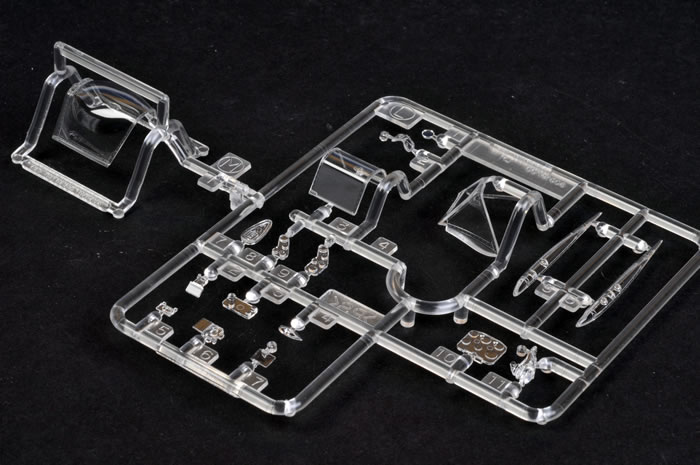
Self-adhesive masks for the canopy parts are also included. The outline is printed on the yellow masking material, and the modeller cuts them out before applying them to the clear parts.
The photo-etched frets provide the aforementioned instrument panel (two versions), plus a Sutton Harness, pilot's armour and smaller details.
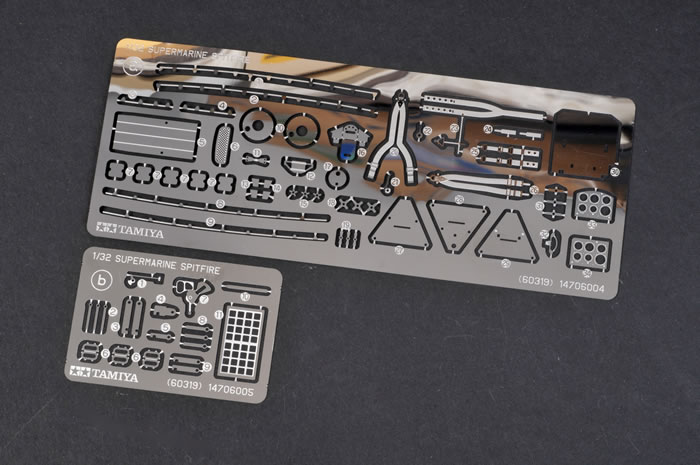
The fuselage is broken down into a two halves of a main centre section, with separate engine cowling panels and a large empennage insert below the tail surfaces. This breakdown suggests that Tamiya plans to release different variants with the retractable tailwheel, perhaps the Spitfire MK.VII and VIII.
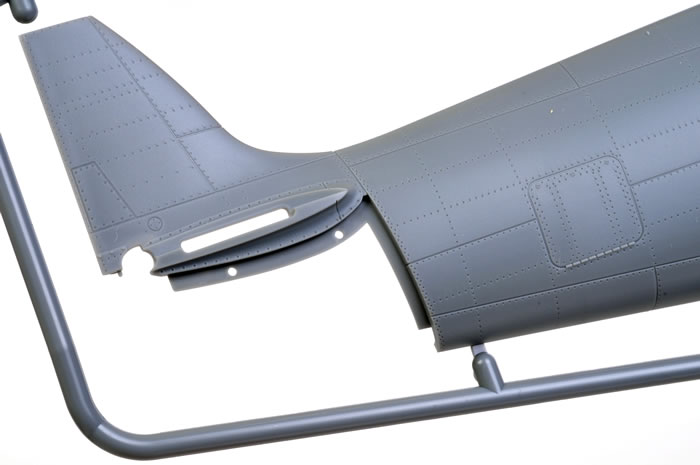
Many optional parts are included in the kit. Most are mentioned in the instructions but some are not. These include:
-
alternate style exhaust stacks (flared or tubular);
-
two styles of lower cowl supercharger intakes (long Aero-Vee and short);
-
two styles of upper cowl (early "flatter" style and the later bulged version, usually seen covering Packard Merlins on the Mk.XVI, plus various blisters and intakes for sub-types),
-
two varieties of separate wing tips (standard and clipped LF);
-
two versions of wing gun covers (standard two-gun C and four gun C, although the four-gun cover seems to be a less common style with a squared-off front);
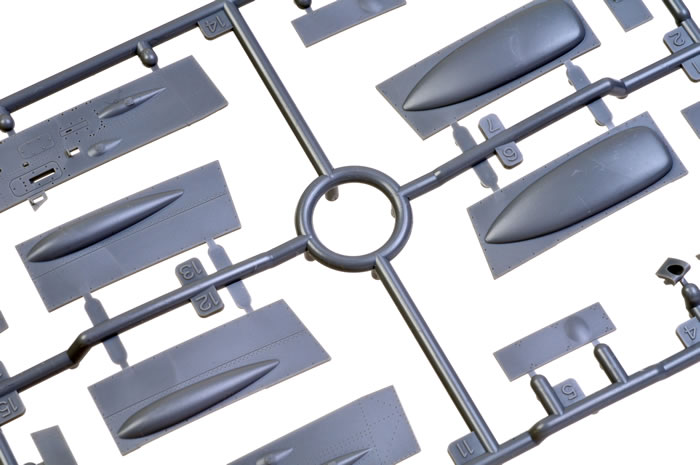
-
slipper style drop tanks;
-
two wing-mounted bombs 250 lb. bombs and racks;
-
three wheel patterns – five spoke and four spoke, both with smooth treaded tyres, and covered hub via photo-etched parts.
-
both styles of elevators are also supplied – the early style with the angled mass balance and the late "double kinked" version. Early (rounded) and late (pointy) rudders are also included.
All of these options mean that the modeller can build virtually any production variant of the high back Spitfire Mk.IXc or Mk.XVIc except for the high altitude versions with the pointed wing tips.
The list of kit features is equally impressive. All control surfaces are separate. The ailerons, elevators and rudder are fitted with metal hinges, while the flaps may be posed open or closed. Alternate parts are supplied to display the undercarriage retracted or extended. This may be changed even after the model has been built thanks to removable fairings on the lower wings.
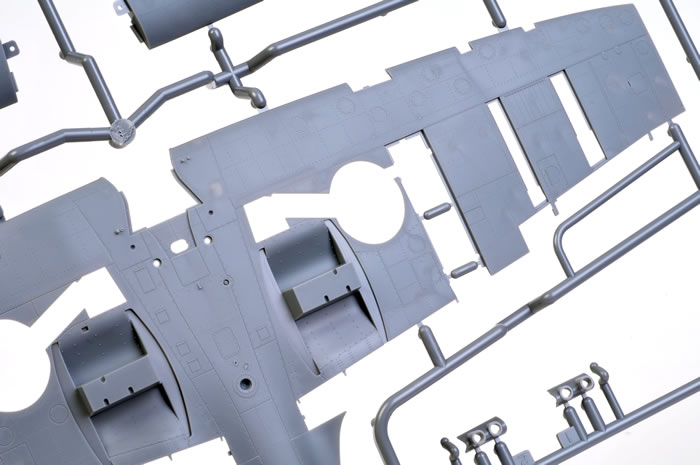
A display stand is supplied for in-flight display.
A beautifully detailed Rolls-Royce Merlin engine is also included. One of the problems of earlier models with detailed engines was that the thickness of the engine cowing plastic meant that the powerplant was undersized. In this case, Tamiya’s cowl panels are a fraction of a millimetre in thickness. Another innovation is the use of tiny magnets to permit the cowl panels to be fitted and removed with ease.
The cockpit is fully equipped with a multi-media sandwich for the instrument panel, photo-etched harness and an optional seated pilot. A standing RAF figure is also included. These figures are very well done, matching the exemplary standard of the rest of the kit.
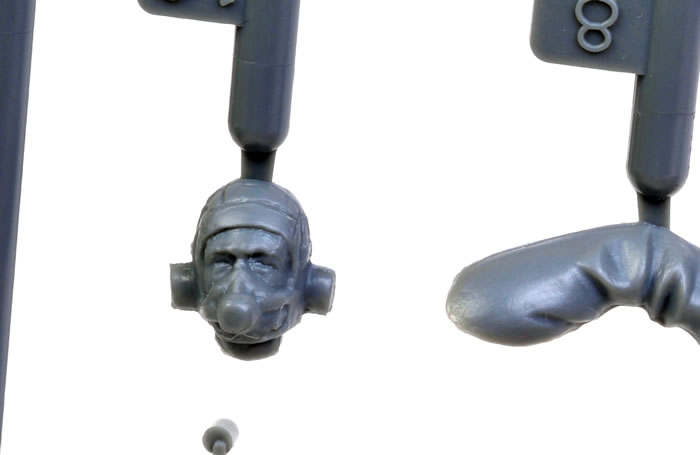
The cockpit door is poseable too.
The tyres are presented in flexible vinyl. Two alternatives are provided - one for extended undercarriage and one for retracted.
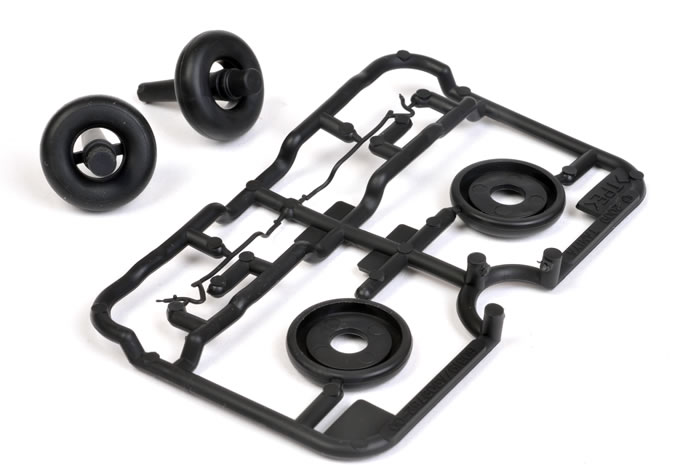
Three varied marking options are supplied on the two decal sheets:
-
JE J, the seemingly ubiquitous Johnny Johnson's Spitfire in standard RAF Day Fighter camouflage of Ocean Grey and Dark Green over Medium Sea Grey.
-
A desert camouflaged Spitfire IXc attached to 145 (Polish) Sqn, Tunisia 1943.
-
A French Air Force Spitfire in Day Fighter colours based at Nha-Trang, Indochina in 1948.
The decals are well printed and in perfect register.

In addition to the intructions and a separate marking guide, this package includes an A5 szed, 16 page full-colour booklet conatining reference photos. This will be especially helpful for painting and detailing the engine.
Tamiya’s 1/32 scale Spitfire Mk.IXc is an extraordinary kit. The level of detail is second to none, and the sheer number of optional parts should please even the fussiest Spitfire-o-phile. As good as it looks in the box though, I’ll bet it will be even nicer to build. I am breaking out the sprue cutters right now!
Thanks to Tamiya Japan for the sample
Text and Images Copyright © 2009 by
Brett Green
Page Created 29 October, 2009
Last updated
30 October, 2009
Back to HyperScale Main Page
|
